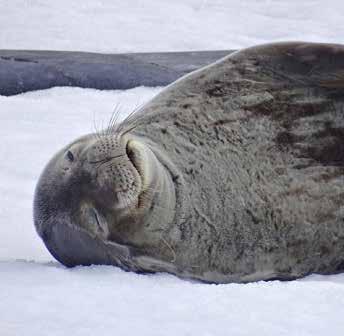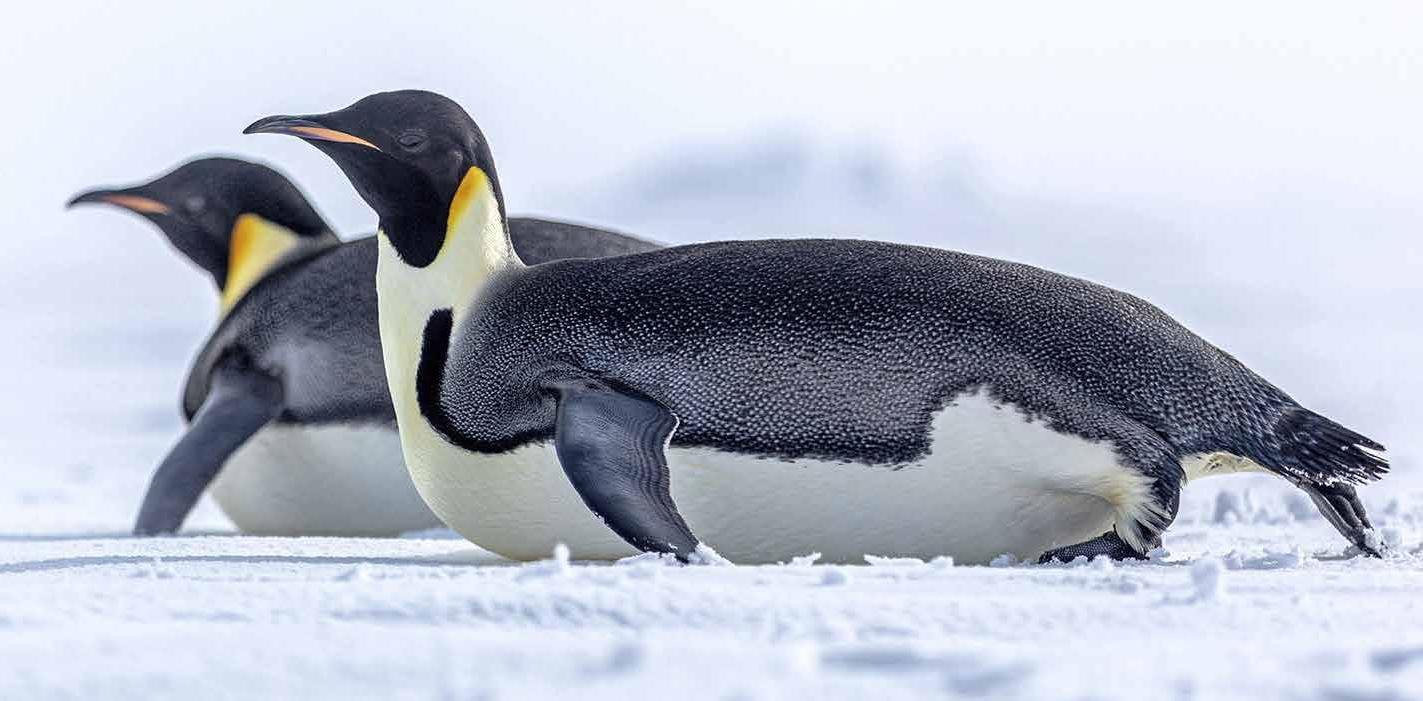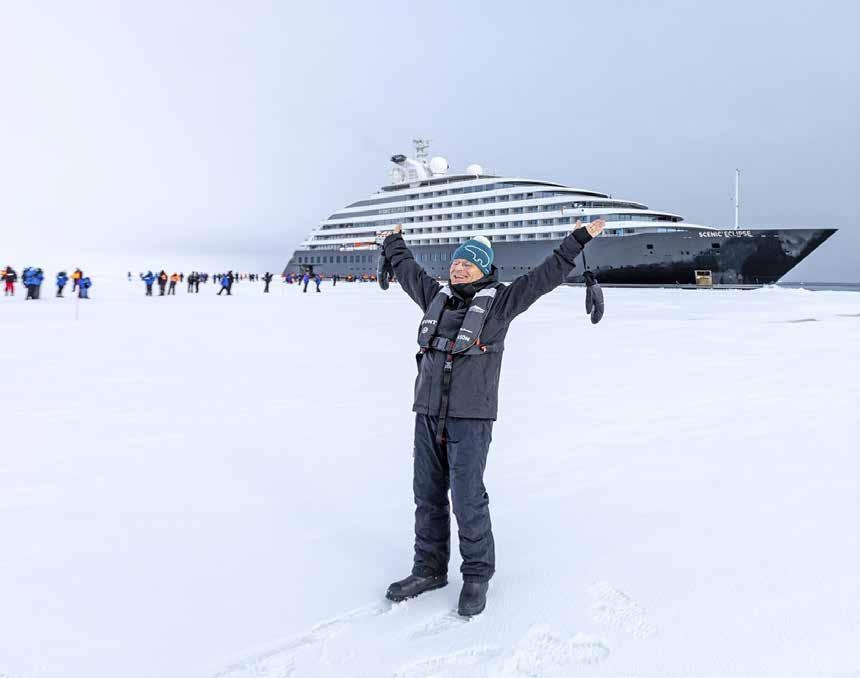
7 minute read
Unrivalled Exploration
Discover The Weddell Sea

Enter the Weddell Sea, a frozen world of magic and wonder, where vast tabular icebergs take your breath away, krill-rich waters support emperor penguins and Adélie penguin colonies a hundred thousand strong. Where world-renowned fossil fields mark Antarctica’s last connection with other continents and the greatest stories of Polar survival have been born. With good reason.

Nearly half the Weddell Sea is covered by the massive, floating, Filchner-Ronne Ice Shelf, the second largest in Antarctica, and smaller ice shelves along the east coast of the Antarctic Peninsula. These ice shelves calve huge, flat-topped icebergs some 30 metres above sea level, 120 metres below and many kilometres long. Powered by deep currents, they slice through fields of frozen sea ice, like icebreakers of the gods. It takes a unique ship to explore these waters and Scenic Eclipse, The World’s First Discovery Yachts™, is in a class of its own. The first to be designed and built to Polar Class 6 standards, its strengthened hull, forward bow thrusters, 50 per cent larger stabilisers and electronic Azipod propulsion system enable safe navigation. Our Polar Discovery Team specialists share their insights into the environment and history of the region. Their expertise allows us to land in places few others have been before. Most have heard the Shackleton story, of how his ship Endurance was trapped and crushed in Weddell Sea pack ice and how he and his men escaped to Elephant Island in lifeboats. Learn how Shackleton and five others sailed from there, to South Georgia, on an epic rescue mission. Who knows the story of Otto Nordenskjold’s, Swedish Antarctic Expedition, who was here more than a decade earlier? Your Discovery Team historian will share the gripping tale of how Nordenskjold lost his support ship Antarctica to pack ice and how this started a series of events combining the hardship, coincidence, sheer good luck and leadership that brought all but one of his men back alive.

D A Emperor penguins, Snow Hill B Nordenskjold’s Hut, Snow Hill C Weddell Seal D Scenic Eclipse, Weddell Sea
C B
Whether by Zodiac or helicopter^, we aim to visit Nordenskjold’s Hut on Snow Hill Island and look for emperor penguins recently departed from the northernmost colony nearby. On adjacent Seymour Island, known as the Rosetta Stone of Antarctic palaeontology, scientists have discovered fossils of giant penguins, marsupials and evidence of the mass extinction event that wiped out the dinosaurs. We’ll search for ephemeral waterfalls on Vega Island, perhaps visit an abandoned British field camp in Duse Bay, and explore volcanic Paulet Island, home to 100,000 breeding pairs of Adélies and the remains of Larsen’s Hut, built in 1903 by the survivors of Antarctica. Explore above, below and beyond the horizon. Our two helicopters^ provide new perspectives on tabular icebergs, the Antarctic Peninsula’s icecap and access to remote fossil fields. Our custombuilt submarine, Scenic Neptune^, enables you to explore the depths of the Weddell Sea where no one else has been. Who knows, there may still be relics of Nordenskjold’s and Shackleton’s lost ships somewhere on the sea floor. Back on board Scenic Eclipse, visit our expansive 550m2 Senses Spa for the pure indulgence of rejuvenating treatments, soak in our Vitality Spa or outdoor Vitality pools, or stretch tightening muscles in our gym. Join your Discovery Leader for an illustrated recap of the day and learn what is planned for the next. After dinner, what better way to finish the day than with a nightcap in one of our nine bars and lounges, admiring evening light playing across the Weddell Sea Ice Factory outside.
^Submarine, helicopter and helicopter experiences at additional cost, subject to regulatory approval, availability, weight restrictions, medical approval and weather and ice conditions. BACK TO CONTENTS
Discover South Georgia & the Falkland Islands
Between South America and the Antarctic Peninsula lies an enchanting island chain, fragments of a land bridge that once connected the two continents called the Scotia Arc. Swept by krill-rich waters from the Weddell Sea, the islands boast a greater range of wildlife than the Galapagos and in numbers that show the abundance of the region.

Imagine king penguin colonies 150,000 strong, or 870,000 breeding pairs of rockhopper penguins. Add fur and elephant seals, sea lions, white sand beaches, soaring glaciated peaks and a thrilling history of whaling, Polar explorers, pioneers and war, all this on just two of best-known of all Scotia Arc islands – the Falklands and South Georgia. Simply put, if you’re planning a trip to Antarctica, add these destinations for the trip of a lifetime. From Ushuaia, indulge in the ultra-luxury experiences of Scenic Eclipse for just over a day to reach the Falkland Islands. Windswept and scarcely populated, this remote archipelago is a birder’s delight. Enjoy close encounters with magnificent black-browed albatross or ‘mollymawks’, sitting on their mud and straw nests. Delight in penguins, from ground burrowing Magellanics to flamboyant-feathered macaroni and rockhoppers, from gentle gentoos to regal kings. Five species of geese, teals and the antics of the flightless steamer duck will also captivate. From clifftop vantages, spy bull sea lions aggressively defending their harems, moving quickly on their flippers like lumbering bears. Watch fur and elephant seals gambolling on beaches, dolphins and orcas patrolling offshore. Spend a day exploring the very-British capital, Stanley. Choose one of our Scenic Freechoice activities – a walking tour of the town or a Battlefield Tour detailing the Falklands War. If feeling more active, join a Scenic Discovery excursion, walk a wildlife trail and to the Magellanic penguin colony at Gypsy Cove. Whether we approach South Georgia from north or south your first view is unforgettable. It might be waters off Bird Island roiling with penguins, fur and elephant seals; or the south coast’s ice-encrusted Salvesen Range soaring 2,330 glorious metres above. Over the next days, your Discovery team will guide you to the best bays, beaches and mountainsides of this 170 km long island, showing you why this is the world’s most important penguin and seabird breeding area.



A B
B
A Gold Harbour, South Georgia B Scenic Eclipse, Drygalski Fjord, South Georgia C Rockhopper penguins, Falkland Islands D Whalers Church, Grytviken, South Georgia
D D C
C Our Discovery Team leader plans to land as often as possible, to take extended hikes or sit quietly enjoying busy beach activities. Zodiac cruise beneath cliffs where light-mantled sooty albatross nest, walk up a boardwalk for close encounters with majestic wandering albatross and chicks. Photograph South Georgia pipits, just one of several species recovering after a successful pest eradication program. Since 1775, when Captain Cook became the first to land on South Georgia, the island has been a base camp for sealers, whalers and Antarctic explorers. Norwegians established the island’s first whaling station in Grytviken in 1904, with six others to follow. Of all the explorers, best known is Ernest Shackleton, who with five of his men, sailed a lifeboat 800 nautical miles across the Southern Ocean, then hiked across the island’s unmapped interior to raise a rescue for the men he left behind on Elephant Island. Join your Discovery Team historian in the Grytviken cemetery to raise a toast at the graves of Shackleton and his right-hand man, Frank Wild, and tour the open-air whaling station, museum and gift shop. Enjoy an all-inclusive kayaking and stand-up paddleboarding excursion, with your Discovery Team guide for an excursion off the island’s largest king penguin rookeries, as birds zoom underneath and all around your craft. Become one of the first people ever to explore the deep waters surrounding South Georgia in the custom-built submarine, Scenic Neptune^. And relax in truly all-inclusive 6-star luxury as you continue along the Scotia Arc through waters that are home to all the great whale species, including blue, fin and sei whales. Depending on ice, weather and sea conditions, we may stop by the South Orkney and Elephant islands, as we follow the Scotia Arc to Antarctica.







